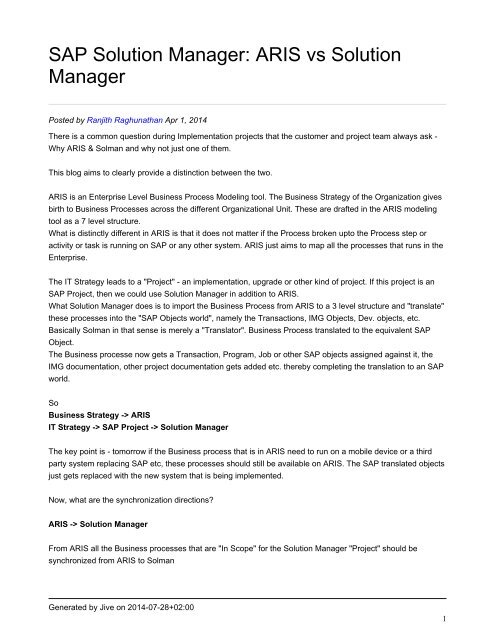ARIS What is
Create successful ePaper yourself
Turn your PDF publications into a flip-book with our unique Google optimized e-Paper software.
SAP Solution Manager: <strong>ARIS</strong> vs Solution<br />
Manager<br />
Posted by Ranjith Raghunathan Apr 1, 2014<br />
There <strong>is</strong> a common question during Implementation projects that the customer and project team always ask -<br />
Why <strong>ARIS</strong> & Solman and why not just one of them.<br />
Th<strong>is</strong> blog aims to clearly provide a d<strong>is</strong>tinction between the two.<br />
<strong>ARIS</strong> <strong>is</strong> an Enterpr<strong>is</strong>e Level Business Process Modeling tool. The Business Strategy of the Organization gives<br />
birth to Business Processes across the different Organizational Unit. These are drafted in the <strong>ARIS</strong> modeling<br />
tool as a 7 level structure.<br />
<strong>What</strong> <strong>is</strong> d<strong>is</strong>tinctly different in <strong>ARIS</strong> <strong>is</strong> that it does not matter if the Process broken upto the Process step or<br />
activity or task <strong>is</strong> running on SAP or any other system. <strong>ARIS</strong> just aims to map all the processes that runs in the<br />
Enterpr<strong>is</strong>e.<br />
The IT Strategy leads to a "Project" - an implementation, upgrade or other kind of project. If th<strong>is</strong> project <strong>is</strong> an<br />
SAP Project, then we could use Solution Manager in addition to <strong>ARIS</strong>.<br />
<strong>What</strong> Solution Manager does <strong>is</strong> to import the Business Process from <strong>ARIS</strong> to a 3 level structure and "translate"<br />
these processes into the "SAP Objects world", namely the Transactions, IMG Objects, Dev. objects, etc.<br />
Basically Solman in that sense <strong>is</strong> merely a "Translator". Business Process translated to the equivalent SAP<br />
Object.<br />
The Business processe now gets a Transaction, Program, Job or other SAP objects assigned against it, the<br />
IMG documentation, other project documentation gets added etc. thereby completing the translation to an SAP<br />
world.<br />
So<br />
Business Strategy -> <strong>ARIS</strong><br />
IT Strategy -> SAP Project -> Solution Manager<br />
The key point <strong>is</strong> - tomorrow if the Business process that <strong>is</strong> in <strong>ARIS</strong> need to run on a mobile device or a third<br />
party system replacing SAP etc, these processes should still be available on <strong>ARIS</strong>. The SAP translated objects<br />
just gets replaced with the new system that <strong>is</strong> being implemented.<br />
Now, what are the synchronization directions?<br />
<strong>ARIS</strong> -> Solution Manager<br />
From <strong>ARIS</strong> all the Business processes that are "In Scope" for the Solution Manager "Project" should be<br />
synchronized from <strong>ARIS</strong> to Solman<br />
Generated by Jive on 2014-07-28+02:00<br />
1
SAP Solution Manager: <strong>ARIS</strong> vs Solution Manager<br />
Ideally, for the Business Processes the synchronization should always be one sided. From <strong>ARIS</strong> to Solman.<br />
Th<strong>is</strong> <strong>is</strong> because of where we started th<strong>is</strong> article from - the processes at the Enterpr<strong>is</strong>e level <strong>is</strong> irrespective of<br />
whether they run in SAP or non-SAP. The processes should first be defined in <strong>ARIS</strong> and if they are running in<br />
the SAP systems then they are translated into the SAP object world in Solman!!!<br />
Solution Manager -> <strong>ARIS</strong><br />
Any SAP artefacts that are created during the "Project" have to be synchronized from Solution Manager to<br />
<strong>ARIS</strong>.<br />
We start with the "Project" itself.<br />
First synchronize the Solman project into <strong>ARIS</strong>, copy the processes into th<strong>is</strong> project and then start your<br />
synchronization to Solman.<br />
Next will be the "Document types" and related "Status values". These have to be defined in Solman project and<br />
then imported into <strong>ARIS</strong> and reused from the Process Library against the processes.<br />
Also the "Systems" which are created in the System Landscape need to be synchronized into <strong>ARIS</strong>. Note here<br />
that the Systems (SAP & non SAP legacy systems) are added to the LMDB of Solman thereby completing the<br />
Technical landscape documentation and then grouped into logical components are assigned to the Project.<br />
Th<strong>is</strong> <strong>is</strong> now reverse synchronized to <strong>ARIS</strong>.<br />
You could also create "End User Roles" in Solman and synchronize back to <strong>ARIS</strong>.<br />
In summary any SAP objects that need to be depicted in the process flow on <strong>ARIS</strong> has to be created in Solman<br />
and send back to <strong>ARIS</strong>.<br />
Hope now that th<strong>is</strong> article provides clarity on whether <strong>ARIS</strong> and Solman need to co-ex<strong>is</strong>t. Once again - Yes,<br />
they should!!!<br />
3539 Views Tags: bpm, ar<strong>is</strong>, solman_toolkit, solution_manager_in_asap, solution_managaer,<br />
business_process_methodology, as<strong>is</strong>, tobe<br />
There are no comments on th<strong>is</strong> post<br />
Generated by Jive on 2014-07-28+02:00<br />
2


